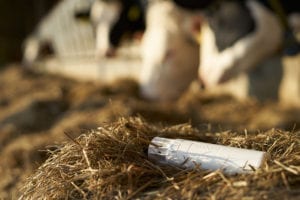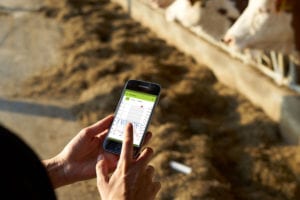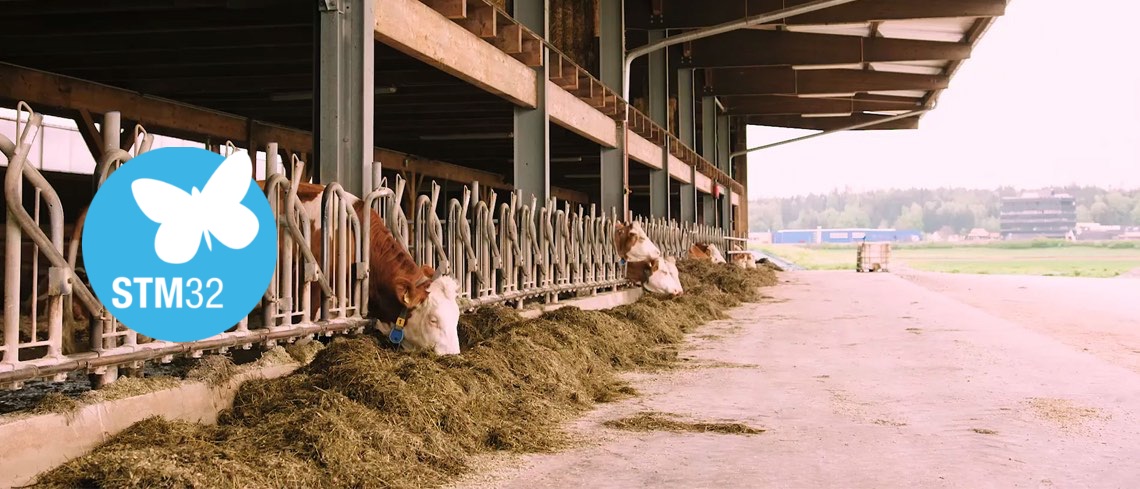To improve the accessibility of our content, please find the audio version of this blog post.
Smart agriculture can show up in the most unexpected places, such as a cow’s rumen in the case of the smaXtec, a health monitoring system from an Austrian company of the same name that uses an STM32WL microcontroller (MCU), and an ST three-axis MEMS accelerometer. The first version of the smaXtec used an STM32L4. After a few years, the company wanted to improve its design. It thus adopted the STM32WL because it integrated the MCU and radio transceiver onto the same housing.
smaXtec will be one of the feature stories we will introduce at The Things Conference, which will take place on September 22 and 23 in Amsterdam. Anicet Giaimo, Product Line Marketing Manager for wireless microcontrollers, will show how companies use STM32WL devices to solve unique problems. Let’s explore why smaXtec turned to the new microcontroller and what it can teach the STM32 community. Blog readers interested in attending the conference can use the code FRIENDS-ST to get 20% off their tickets.
Table of Contents
Why does smart agriculture thirst for better data?
smaXtec: the first LoRa-enabled bolus
The rumen is the first chamber of the cow’s alimentary canal. It’s where the animal mixes and starts digesting food. Hence, farmers have taken advantage of it since the 1970s to store small capsules named boluses. The first bolus only contained vitamins and minerals and would dissolve over a month. Scientists then used boluses to give medicines or track animals’ vitals. smaXtec is the first LoRa-enabled bolus. It is small (105 mm x 35 mm) and monitors physiological data, such as pH, water intake, temperature, internal contractions, etc. It helps determine when the cow is in heat or about to get sick, among other things, thus significantly increasing the chances of fertilization or reducing the use of antibiotics.
Optimizing artificial insemination to improve breeding rates
Artificial insemination opened farmers to substantial savings compared to natural services, removing the costs of breeding and caring for a bull. Nevertheless, artificial insemination is still a hot scientific topic as scholars search for the techniques that will yield the best results. The College of Agricultural Sciences at the Pennsylvania State University estimates that technicians who recently received training have an average breeding rate of about 70%. Hence, there is room for improvement, especially as the prices for bull semen continue to increase. In the testimony below, a farmer explains how his “time to pregnant” shrunk by nearly half after installing smaXtec boluses.
Reducing the use of antibiotics by 70% for healthier agriculture
The overuse of antibiotics in animal feed is another critical issue. According to a New York Times investigation published in 2018, some breeders add antibiotics to the feed and water, even if the animal doesn’t show any sign of sickness. They do it in the name of disease prevention and because the drugs ensure cows grow fatter more rapidly. The problem is that it leads to the breeding of drug-resistant bacteria that will then live in the human digestive tract and wreak havoc. Thanks to its smart bolus, smaXtec saw farmers reduce their use of antibiotics by 70%.
How to get better data?
Precise sensors

To resolve the insemination challenge, the smaXtec system must determine, with precision, when a cow is not only in heat but when the estrus cycle begins. Indeed, it is at this precise time that the animal will be most fertile, but it happens at the end of the “standing heat” phase. And once the animal has reached this stage, farmers only have about 12 hours to induce ovulation before it’s too late. The process thus demands an accurate reading of the animal’s state that a visual analysis can’t provide. Thanks in part to the ST sensor, the smaXtec bolus can track drinking behaviors and the rumen’s pH, which provides vastly more accurate readings.
Fast transfers
Similarly, sensors on the smaXtec can track temperatures and other behaviors to anticipate when an animal will get sick. Moreover, in cases of heat or fever detection, the information must travel rapidly to the cloud to notify farmers. Hence, smaXtec adopted the STM32WL and LoRaWAN® to send data to a cloud platform. Breeders get a notification on their smartphones and can thus monitor the state of their livestock in near real-time. Sensors record information every minute, and the microcontroller sends data to the cloud every ten minutes.
Energy efficiency
To be practical, a smaXtec bolus must last four years on a single battery. The reason is that it’s the typical timeframe in which a dairy cow is productive. Long battery life means a breeder only needs one bolus per animal. The Austrian company thus used an ST MEMS accelerometer with an active low-power mode. Similarly, smaXtec uses an STM32WL to improve efficiency further. The fact that the radio transceiver is inside the same package as the MCU means there are fewer external components to power.
Another way the smaXtec bolus improves its efficiency is by using a processing algorithm that limits the amount of data sent to the cloud. Performing some operations locally will always be more efficient than waking the RF for extended periods. The bolus can thus benefit from the greater efficiency of the STM32WL without any performance penalty.
Practical application
Another important consideration is the system’s footprint. A bolus that’s too large would generate significant discomfort to the animal. Hence, smaXtec chose an ST MEMS available in a small and thin package. The company also moved to the STM32WL because it simplified the overall design and shrunk the PCB. For instance, thanks to the MCU, the smaXtec team only needs to use one crystal for the Cortex® core and the LoRa transceiver. It keeps the overall design small to make it easy to swallow and to help farmers install the boluses faster. According to their customer, farmers can install 400 boluses in one day.
How to get started?

smaXtec used our Nucleo boards to test some of our MCUs and experiment with some of our software solutions. To facilitate developments, the company used our STM32CubeWL, a package that contains the STM32CubeMX graphical user interface on top of the hardware abstraction layers and low-level APIs that ensure developers jumpstart their application on our MCU. STM32CubeWL also includes a LoRaWAN stack to create a sub-gigahertz application rapidly. Using ST code can also help obtain regional wireless certifications faster. Since we ensure that our implementation meets the most common regulatory imperatives, using our code helps developers start the certification process more confidently.




